Joint Effect of Spartina alterniflora Invasion and Reclamation on the Spatial and Temporal Dynamics of Tidal Flats in Yangtze River Estuary
Abstract
:1. Introduction
- To generate tidal flat mapping in YRE during the period 1996–2018;
- To analyze the spatial and temporal dynamics of tidal flats in YRE;
- To explore the influence of reclamation and plant invasion on the development of tidal flats in YRE.
2. Materials and Methods
2.1. Study Area
2.2. Landsat Data and Pre-Processing
2.3. Algorithm to Identify Open Surface Water Body, Vegetation, and Tidal Flats
2.3.1. Open Surface Water Body and Vegetation Annual Frequency Mapping
2.3.2. Identification of Annual Tidal Flats
2.4. Identification of Dike and S. alterniflora
2.5. Calculating Accumulated and Expanded Tidal Flats Area
2.6. Stastical Analysis of Relationship between Tidal Flats Dynamics and Driving Factors
3. Results
3.1. Accuracy Assessment for Image Classification
3.2. Spatiotemporal Dynamics of Tidal Flats Area in YRE
3.3. Major Driving Factors of Tidal Flats Expansion Patterns
4. Discussion
4.1. Reliability and Uncertainty of Tidal Flats Mapping
4.2. Impact of S. alterniflora Invasion on Tidal Flats Expansion Patterns
4.3. Impact of Ecological Engineering on Tidal Flats Expansion Patterns
4.4. Joint Effect of S. alterniflora Invasion and Reclamation on Tidal Flats
4.5. Future Tidal Flats in YRE
5. Conclusions
Author Contributions
Funding
Acknowledgments
Conflicts of Interest
References
- Quammen, M.L. Predation by shorebirds, fish, and crabs on invertebrates in intertidal mudflats: An experimental test. Ecology 1984, 65, 529–537. [Google Scholar] [CrossRef]
- Warwick, R.M.; Price, R. Ecological and metabolic studies on free-living nematodes from an estuarine mud-flat. Estuar. Coast. Mar. Sci. 1979, 9, 257–271. [Google Scholar] [CrossRef]
- Li, B.; Liao, C.; Zhang, X.; Chen, H.; Wang, Q.; Chen, Z.; Gan, X.; Wu, J.; Zhao, B.; Ma, Z.; et al. Spartina alterniflora invasions in the Yangtze River estuary, China: An overview of current status and ecosystem effects. Ecol. Eng. 2009, 35, 511–520. [Google Scholar] [CrossRef]
- Ma, Z.; Wang, Y.; Gan, X.; Li, B.; Cai, Y.; Chen, J. Waterbird population changes in the wetlands at Chongming Dongtan in the Yangtze River estuary, China. Environ. Manag. 2009, 43, 1187–1200. [Google Scholar] [CrossRef]
- Ghosh, S.; Mishra, D.R.; Gitelson, A.A. Long-term monitoring of biophysical characteristics of tidal wetlands in the northern Gulf of Mexico—A methodological approach using MODIS. Remote Sens. Environ. 2016, 173, 39–58. [Google Scholar] [CrossRef] [Green Version]
- Jin, H.; Huang, C.; Lang, M.W.; Yeo, I.-Y.; Stehman, S.V. Monitoring of wetland inundation dynamics in the Delmarva Peninsula using Landsat time-series imagery from 1985 to 2011. Remote Sens. Environ. 2017, 190, 26–41. [Google Scholar] [CrossRef] [Green Version]
- Murray, N.J.; Ma, Z.; Fuller, R.A. Tidal flats of the Yellow Sea: A review of ecosystem status and anthropogenic threats. Austral Ecol. 2015, 40, 472–481. [Google Scholar] [CrossRef]
- Murray, N.J.; Phinn, S.R.; DeWitt, M.; Ferrari, R.; Johnston, R.; Lyons, M.B.; Clinton, N.; Thau, D.; Fuller, R.A. The global distribution and trajectory of tidal flats. Nature 2019, 565, 222–225. [Google Scholar] [CrossRef]
- Yang, S.L.; Belkin, I.M.; Belkina, A.I.; Zhao, Q.Y.; Zhu, J.; Ding, P.X. Delta response to decline in sediment supply from the Yangtze River: Evidence of the recent four decades and expectations for the next half-century. Estuar. Coast. Shelf Sci. 2003, 57, 689–699. [Google Scholar] [CrossRef]
- Chen, J.; Zhao, B.; Ren, W.; Saunders, S.C.; Ma, Z.; Li, B.; Luo, Y.; Chen, J. Invasive Spartina and reduced sediments: Shanghai’s dangerous silver bullet. J. Plant Ecol. 2008, 1, 79–84. [Google Scholar] [CrossRef] [Green Version]
- Blum, M.D.; Roberts, H.H. Drowning of the Mississippi Delta due to insufficient sediment supply and global sea-level rise. Nat. Geosci. 2009, 2, 488–491. [Google Scholar] [CrossRef]
- Syvitski, J.P.M.; Kettner, A.J.; Overeem, I.; Hutton, E.W.H.; Hannon, M.T.; Brakenridge, G.R.; Day, J.; Vörösmarty, C.; Saito, Y.; Giosan, L.; et al. Sinking deltas due to human activities. Nat. Geosci. 2009, 2, 681–686. [Google Scholar] [CrossRef]
- Chu, Z.; Yang, X.; Feng, X.; Fan, D.; Li, Y.; Shen, X.; Miao, A. Temporal and spatial changes in coastline movement of the Yangtze delta during 1974–2010. J. Asian Earth Sci. 2013, 66, 166–174. [Google Scholar] [CrossRef]
- Chen, L.; Ren, C.; Zhang, B.; Li, L.; Wang, Z.; Song, K. Spatiotemporal dynamics of coastal wetlands and reclamation in the Yangtze Estuary during past 50 years (1960s–2015). Chin. Geogr. Sci. 2018, 28, 386–399. [Google Scholar] [CrossRef] [Green Version]
- Chung, C.H.; Zhuo, R.Z.; Xu, G.W. Creation of Spartina plantations for reclaiming Dongtai, China, tidal flats and offshore sands. Ecol. Eng. 2004, 23, 135–150. [Google Scholar] [CrossRef]
- Mack, R.N.; Simberloff, D.; Mark Lonsdale, W.; Evans, H.; Clout, M.; Bazzaz, F.A. Biotic invasions: Causes, epidemiology, global consequences, and control. Ecol. Appl. 2000, 10, 689–710. [Google Scholar] [CrossRef]
- Chen, J.; Li, D.; Jin, W. Eco-engineering of Jiuduansha Island caused by Pudong International Airport construction. Eng. Sci. 2001, 3, 1–8. [Google Scholar]
- Zhang, D.; Hu, Y.; Liu, M.; Chang, Y.; Sun, L. Geographical variation and influencing factors of Spartina alterniflora expansion rate in coastal China. Chin. Geogr. Sci. 2020, 30, 127–141. [Google Scholar] [CrossRef] [Green Version]
- Zou, Y.-A.; Tang, C.-D.; Niu, J.-Y.; Wang, T.-H.; Xie, Y.-H.; Guo, H. Migratory waterbirds response to coastal habitat changes: Conservation implications from long-term detection in the Chongming Dongtan Wetlands, China. Estuaries Coasts 2016, 39, 273–286. [Google Scholar] [CrossRef]
- Wang, A.; Chen, J.; Jing, C.; Ye, G.; Wu, J.; Huang, Z.; Zhou, C. Monitoring the invasion of Spartina alterniflora from 1993 to 2014 with Landsat TM and SPOT 6 Satellite data in Yueqing Bay, China. PLoS ONE 2015, 10, e0135538. [Google Scholar] [CrossRef] [Green Version]
- Zhang, D.; Hu, Y.; Liu, M.; Chang, Y.; Yan, X.; Bu, R.; Zhao, D.; Li, Z. Introduction and spread of an exotic plant, Spartina alterniflora, along coastal marshes of China. Wetlands 2017, 37, 1181–1193. [Google Scholar] [CrossRef]
- Liu, M.; Li, H.; Li, L.; Man, W.; Jia, M.; Wang, Z.; Lu, C. Monitoring the invasion of Spartina alterniflora using multi-source high-resolution imagery in the Zhangjiang Estuary, China. Remote Sens. 2017, 9, 539. [Google Scholar] [CrossRef] [Green Version]
- Liu, M.; Mao, D.; Wang, Z.; Li, L.; Man, W.; Jia, M.; Ren, C.; Zhang, Y. Rapid invasion of Spartina alterniflora in the coastal zone of mainland China: New observations from Landsat OLI images. Remote Sens. 2018, 10, 1933. [Google Scholar] [CrossRef] [Green Version]
- Tang, L.; Gao, Y.; Wang, J.; Wang, C.; Li, B.; Chen, J.; Zhao, B. Designing an effective clipping regime for controlling the invasive plant Spartina alterniflora in an estuarine salt marsh. Ecol. Eng. 2009, 35, 874–881. [Google Scholar] [CrossRef]
- Tang, C.-D. Ecological control of Spartina alternilfora and improvement of birds habitats in Chongming Dongtan Wetland, Shanghai. Wetl. Sci. Manag. 2016, 12, 4–8. [Google Scholar] [CrossRef]
- Zhao, B.; Guo, H.; Yan, Y.; Wang, Q.; Li, B. A simple waterline approach for tidelands using multi-temporal satellite images: A case study in the Yangtze Delta. Estuar. Coast. Shelf Sci. 2008, 77, 134–142. [Google Scholar] [CrossRef]
- Chen, B.; Xiao, X.; Li, X.; Pan, L.; Doughty, R.; Ma, J.; Dong, J.; Qin, Y.; Zhao, B.; Wu, Z.; et al. A mangrove forest map of China in 2015: Analysis of time series Landsat 7/8 and Sentinel-1A imagery in Google Earth Engine cloud computing platform. ISPRS J. Photogramm. Remote Sens. 2017, 131, 104–120. [Google Scholar] [CrossRef]
- Friedl, M.A.; McIver, D.K.; Hodges, J.C.F.; Zhang, X.Y.; Muchoney, D.; Strahler, A.H.; Woodcock, C.E.; Gopal, S.; Schneider, A.; Cooper, A.; et al. Global land cover mapping from MODIS: Algorithms and early results. Remote Sens. Environ. 2002, 83, 287–302. [Google Scholar] [CrossRef]
- Friedl, M.A.; Sulla-Menashe, D.; Tan, B.; Schneider, A.; Ramankutty, N.; Sibley, A.; Huang, X. MODIS Collection 5 global land cover: Algorithm refinements and characterization of new datasets. Remote Sens. Environ. 2010, 114, 168–182. [Google Scholar] [CrossRef]
- Bartholomé, E.; Belward, A.S. GLC2000: A new approach to global land cover mapping from Earth observation data. Int. J. Remote Sens. 2005, 26, 1959–1977. [Google Scholar] [CrossRef]
- Loveland, T.R.; Reed, B.C.; Brown, J.F.; Ohlen, D.O.; Zhu, Z.; Yang, L.; Merchant, J.W. Development of a global land cover characteristics database and IGBP DISCover from 1 km AVHRR data. Int. J. Remote Sens. 2000, 21, 1303–1330. [Google Scholar] [CrossRef]
- Hansen, M.C.; Defries, R.S.; Townshend, J.R.G.; Sohlberg, R. Global land cover classification at 1 km spatial resolution using a classification tree approach. Int. J. Remote Sens. 2000, 21, 1331–1364. [Google Scholar] [CrossRef]
- Tateishi, R.; Uriyangqai, B.; Al-Bilbisi, H.; Ghar, M.A.; Tsend-Ayush, J.; Kobayashi, T.; Kasimu, A.; Hoan, N.T.; Shalaby, A.; Alsaaideh, B.; et al. Production of global land cover data–GLCNMO. Int. J. Remote Sens. 2011, 4, 22–49. [Google Scholar] [CrossRef]
- Gong, P.; Wang, J.; Yu, L.; Zhao, Y.; Zhao, Y.; Liang, L.; Niu, Z.; Huang, X.; Fu, H.; Liu, S.; et al. Finer resolution observation and monitoring of global land cover: First mapping results with Landsat TM and ETM+ data. Int. J. Remote Sens. 2013, 34, 2607–2654. [Google Scholar] [CrossRef] [Green Version]
- Gong, P.; Liu, H.; Zhang, M.; Li, C.; Wang, J.; Huang, H.; Clinton, N.; Ji, L.; Li, W.; Bai, Y.; et al. Stable classification with limited sample: Transferring a 30-m resolution sample set collected in 2015 to mapping 10-m resolution global land cover in 2017. Sci. Bull. 2019, 64, 370–373. [Google Scholar] [CrossRef] [Green Version]
- Gong, P.; Niu, Z.; Cheng, X.; Zhao, K.; Zhou, D.; Guo, J.; Liang, L.; Wang, X.; Li, D.; Huang, H.; et al. China’s wetland change (1990–2000) determined by remote sensing. Sci. China Earth Sci. 2010, 53, 1036–1042. [Google Scholar] [CrossRef]
- Niu, Z.; Zhang, H.; Wang, X.; Yao, W.; Zhou, D.; Zhao, K.; Zhao, H.; Li, N.; Huang, H.; Li, C.; et al. Mapping wetland changes in China between 1978 and 2008. Chin. Sci. Bull. 2012, 57, 2813–2823. [Google Scholar] [CrossRef] [Green Version]
- Yan, F.; Liu, X.; Chen, J.; Yu, L.; Yang, C.; Chang, L.; Yang, J.; Zhang, S. China’s wetland databases based on remote sensing technology. Chin. Geogr. Sci. 2017, 27, 374–388. [Google Scholar] [CrossRef] [Green Version]
- Chen, Y.; Dong, J.; Xiao, X.; Zhang, M.; Tian, B.; Zhou, Y.; Li, B.; Ma, Z. Land claim and loss of tidal flats in the Yangtze Estuary. Sci. Rep. 2016, 6, 1–10. [Google Scholar] [CrossRef]
- Zhang, K.; Dong, X.; Liu, Z.; Gao, W.; Hu, Z.; Wu, G. Mapping tidal flats with Landsat 8 images and Google Earth Engine: A case study of the China’s eastern coastal zone circa 2015. Remote Sens. 2019, 11, 924. [Google Scholar] [CrossRef] [Green Version]
- Han, Q.; Niu, Z.; Wu, M.; Wang, J. Remote-sensing monitoring and analysis of China intertidal zone changes based on tidal correction. Chin. Sci. Bull. 2018, 64, 456–473. [Google Scholar] [CrossRef] [Green Version]
- Wang, X.; Xiao, X.; Zou, Z.; Chen, B.; Ma, J.; Dong, J.; Doughty, R.B.; Zhong, Q.; Qin, Y.; Dai, S.; et al. Tracking annual changes of coastal tidal flats in China during 1986–2016 through analyses of Landsat images with Google Earth Engine. Remote Sens. Environ. 2018, 238, 110987. [Google Scholar] [CrossRef]
- Chen, Y.; Dong, J.; Xiao, X.; Ma, Z.; Tan, K.; Melville, D.; Li, B.; Lu, H.; Liu, J.; Liu, F. Effects of reclamation and natural changes on coastal wetlands bordering China’s Yellow Sea from 1984 to 2015. Land Degrad. Dev. 2019, 30, 1533–1544. [Google Scholar] [CrossRef]
- Casu, F.; Manunta, M.; Agram, P.S.; Crippen, R.E. Big remotely sensed sata: Tools, applications and experiences. Remote Sens. Environ. 2017, 202, 1–2. [Google Scholar] [CrossRef]
- Gorelick, N.; Hancher, M.; Dixon, M.; Ilyushchenko, S.; Thau, D.; Moore, R. Google Earth Engine: Planetary-scale geospatial analysis for everyone. Remote Sens. Environ. 2017, 202, 18–27. [Google Scholar] [CrossRef]
- Zhao, B.; Yan, Y.; Guo, H.; He, M.; Gu, Y.; Li, B. Monitoring rapid vegetation succession in estuarine wetland using time series MODIS-based indicators: An application in the Yangtze River Delta area. Ecol. Indic. 2009, 9, 346–356. [Google Scholar] [CrossRef]
- He, M. Integration of Field Hyperspectral Data and Satellite Imagery in Monitoring the Invasion of Spartina Alterniflora in Chongming Island. Master’s Thesis, Fudan University, Shanghai, China, 2008. [Google Scholar]
- Tucker, C.J. Red and photographic infrared linear combinations for monitoring vegetation. Remote Sens. Environ. 1979, 8, 127–150. [Google Scholar] [CrossRef] [Green Version]
- Huete, A. A comparison of vegetation indices over a global set of TM images for EOS-MODIS. Remote Sens. Environ. 1997, 59, 440–451. [Google Scholar] [CrossRef]
- Huete, A.; Didan, K.; Miura, T.; Rodriguez, E.P.; Gao, X.; Ferreira, L.G. Overview of the radiometric and biophysical performance of the MODIS vegetation indices. Remote Sens. Environ. 2002, 83, 195–213. [Google Scholar] [CrossRef]
- Xu, H. Modification of normalised difference water index (NDWI) to enhance open water features in remotely sensed imagery. Int. J. Remote Sens. 2006, 27, 3025–3033. [Google Scholar] [CrossRef]
- Gao, B. NDWI—A normalized difference water index for remote sensing of vegetation liquid water from space. Remote Sens. Environ. 1996, 58, 257–266. [Google Scholar] [CrossRef]
- Xiao, X. Modeling gross primary production of temperate deciduous broadleaf forest using satellite images and climate data. Remote Sens. Environ. 2004, 91, 256–270. [Google Scholar] [CrossRef]
- Zou, Z.; Dong, J.; Menarguez, M.A.; Xiao, X.; Qin, Y.; Doughty, R.B.; Hooker, K.V.; David Hambright, K. Continued decrease of open surface water body area in Oklahoma during 1984–2015. Sci. Total Environ. 2017, 595, 451–460. [Google Scholar] [CrossRef]
- Xiao, X.; Boles, S.; Liu, J.; Zhuang, D.; Frolking, S.; Li, C.; Salas, W.; Moore, B. Mapping paddy rice agriculture in southern China using multi-temporal MODIS images. Remote Sens. Environ. 2005, 95, 480–492. [Google Scholar] [CrossRef]
- Xiao, X.; Boles, S.; Frolking, S.; Li, C.; Babu, J.Y.; Salas, W.; Moore, B. Mapping paddy rice agriculture in South and Southeast Asia using multi-temporal MODIS images. Remote Sens. Environ. 2006, 100, 95–113. [Google Scholar] [CrossRef]
- Zou, Z.; Xiao, X.; Dong, J.; Qin, Y.; Doughty, R.B.; Menarguez, M.A.; Zhang, G.; Wang, J. Divergent trends of open-surface water body area in the contiguous United States from 1984 to 2016. Proc. Natl. Acad. Sci. USA 2018, 115, 3810–3815. [Google Scholar] [CrossRef] [Green Version]
- Xiao, X.; Biradar, C.M.; Czarnecki, C.; Alabi, T.; Keller, M. A simple algorithm for large-scale mapping of evergreen forests in tropical America, Africa and Asia. Remote Sens. 2009, 1, 355–374. [Google Scholar] [CrossRef] [Green Version]
- He, M.; Zhao, B.; Ouyang, Z.; Yan, Y.; Li, B. Linear spectral mixture analysis of Landsat TM data for monitoring invasive exotic plants in estuarine wetlands. Int. J. Remote Sens. 2010, 31, 4319–4333. [Google Scholar] [CrossRef]
- Ouyang, Z.-T.; Zhang, M.-Q.; Xie, X.; Shen, Q.; Guo, H.-Q.; Zhao, B. A comparison of pixel-based and object-oriented approaches to VHR imagery for mapping saltmarsh plants. Ecol. Inform. 2011, 6, 136–146. [Google Scholar] [CrossRef]
- Yang, S.L. Sedimentation on a growing intertidal island in the Yangtze River Mouth. Estuar. Coast. Shelf Sci. 1999, 49, 401–410. [Google Scholar] [CrossRef]
- Chen, B.; Xiao, X.; Ye, H.; Ma, J.; Doughty, R.; Li, X.; Zhao, B.; Wu, Z.; Sun, R.; Dong, J.; et al. Mapping forest and their spatial–temporal changes from 2007 to 2015 in tropical Hainan Island by integrating ALOS/ALOS-2 L-band SAR and Landsat optical images. IEEE J. Sel. Top. Appl. Earth Observ. Remote Sens. 2018, 11, 852–867. [Google Scholar] [CrossRef]
- Wang, X.; Xiao, X.; Zou, Z.; Hou, L.; Qin, Y.; Dong, J.; Doughty, R.B.; Chen, B.; Zhang, X.; Chen, Y.; et al. Mapping coastal wetlands of China using time series Landsat images in 2018 and Google Earth Engine. ISPRS J. Photogramm. Remote Sens. 2020, 163, 312–326. [Google Scholar] [CrossRef]
- Peng, Z.-Y.; Jiang, X.-Z.; Hou, L.-J.; He, Q. Comparison of suspended sediment and salinity profile characteristics of the maximum turbidity zone in the Yangtze estuary during the dry season in 1982 and 2012. Mar. Geol. Front. 2020, 36, 7–18. [Google Scholar]
- Callaway, J.C.; Josselyn, M.N. The introduction and spread of smooth cordgrass (Spartina alterniflora) in South San Francisco Bay. Estuaries 1992, 15, 218–226. [Google Scholar] [CrossRef]
- Chung, C.-H. Forty years of ecological engineering with Spartina plantations in China. Ecol. Eng. 2006, 27, 49–57. [Google Scholar] [CrossRef]
- Bu, N.; Qu, J.; Li, Z.; Li, G.; Zhao, H.; Zhao, B.; Li, B.; Chen, J.; Fang, C. Effects of Spartina alterniflora invasion on soil respiration in the Yangtze River estuary, China. PLoS ONE 2015, 10, e0121571. [Google Scholar] [CrossRef] [PubMed]
- Wang, J.; Zhang, X.; Nie, M.; Fu, C.; Chen, J.; Li, B. Exotic Spartina alterniflora provides compatible habitats for native estuarine crab Sesarma dehaani in the Yangtze River estuary. Ecol. Eng. 2008, 34, 57–64. [Google Scholar] [CrossRef]
- Zhang, X.; Jia, X.; Chen, Y.; Shao, J.; Wu, X.; Shang, L.; Li, B. Crabs mediate interactions between native and invasive salt marsh plants: A mesocosm study. PLoS ONE 2013, 8, e74095. [Google Scholar] [CrossRef] [PubMed] [Green Version]
- Zhang, Y.; Pennings, S.C.; Li, B.; Wu, J. Biotic homogenization of wetland nematode communities by exotic Spartina alterniflora in China. Ecology 2019, 100, e02596. [Google Scholar] [CrossRef]
- Chen, H.; Li, B.; Hu, J.; Chen, J.; Wu, J. Effects of Spartina alterniflora invasion on benthic nematode communities in the Yangtze Estuary. Mar. Ecol. Prog. Ser. 2007, 336, 99–110. [Google Scholar] [CrossRef]
- Wu, Y.-T.; Wang, C.-H.; Zhang, X.-D.; Zhao, B.; Jiang, L.-F.; Chen, J.-K.; Li, B. Effects of saltmarsh invasion by Spartina alterniflora on arthropod community structure and diets. Biol. Invasions 2009, 11, 635–649. [Google Scholar] [CrossRef]
- Sun, K.; Yu, W.; Jiang, J.; Richards, C.; Siemann, E.; Ma, J.; Li, B.; Ju, R. Mismatches between the resources for adult herbivores and their offspring suggest invasive Spartina alterniflora is an ecological trap. J. Ecol. 2020, 108, 719–732. [Google Scholar] [CrossRef]
- Xiao, D.; Zhang, L.; Zhu, Z. The range expansion patterns of Spartina alterniflora on salt marshes in the Yangtze Estuary, China. Estuar. Coast. Shelf Sci. 2010, 88, 99–104. [Google Scholar] [CrossRef]
- Zhu, C.; Zhang, X.; Qi, J. Detecting and assessing Spartina invasion in coastal region of China: A case study in the Xiangshan Bay. Acta Oceanol. Sin. 2016, 35, 35–43. [Google Scholar] [CrossRef]
- Li, M. The effect of reclamation in areas between islands in a complex tidal estuary on the hydrodynamic sediment environment. J. Hydrodyn. 2010, 22, 338–350. [Google Scholar] [CrossRef]
- Xie, W.; He, Q.; Zhang, D.; Zhu, L.; Guo, L.; Wang, X. The response of morphplogy and sediment characteristics to human modification in an estuarine tidal flat. Acta Oceanol. Sin. 2019, 41, 118–127. [Google Scholar]
- Gao, Y.; Zhang, T.; Zhang, T.-T.; Wang, S.-K.; Song, C.; Zhuang, P. Assessment of the siltation promotion and reclamation in the east beach of Chongming Island based on sediment volume. Wetl. Sci. Manag. 2017, 13, 4–8. [Google Scholar]
- Wei, W.; Mei, X.; Dai, Z.; Tang, Z. Recent morphodynamic evolution of the largest uninhibited island in the Yangtze (Changjiang) estuary during 1998–2014: Influence of the anthropogenic interference. Cont. Shelf Res. 2016, 124, 83–94. [Google Scholar] [CrossRef] [Green Version]
- Gao, Y.; Zhao, B. The effect of reclamation on mud flat development in Chongming Island, Shanghai. Chin. Agric. Sci. Bull. 2006, 22, 475–479. [Google Scholar]
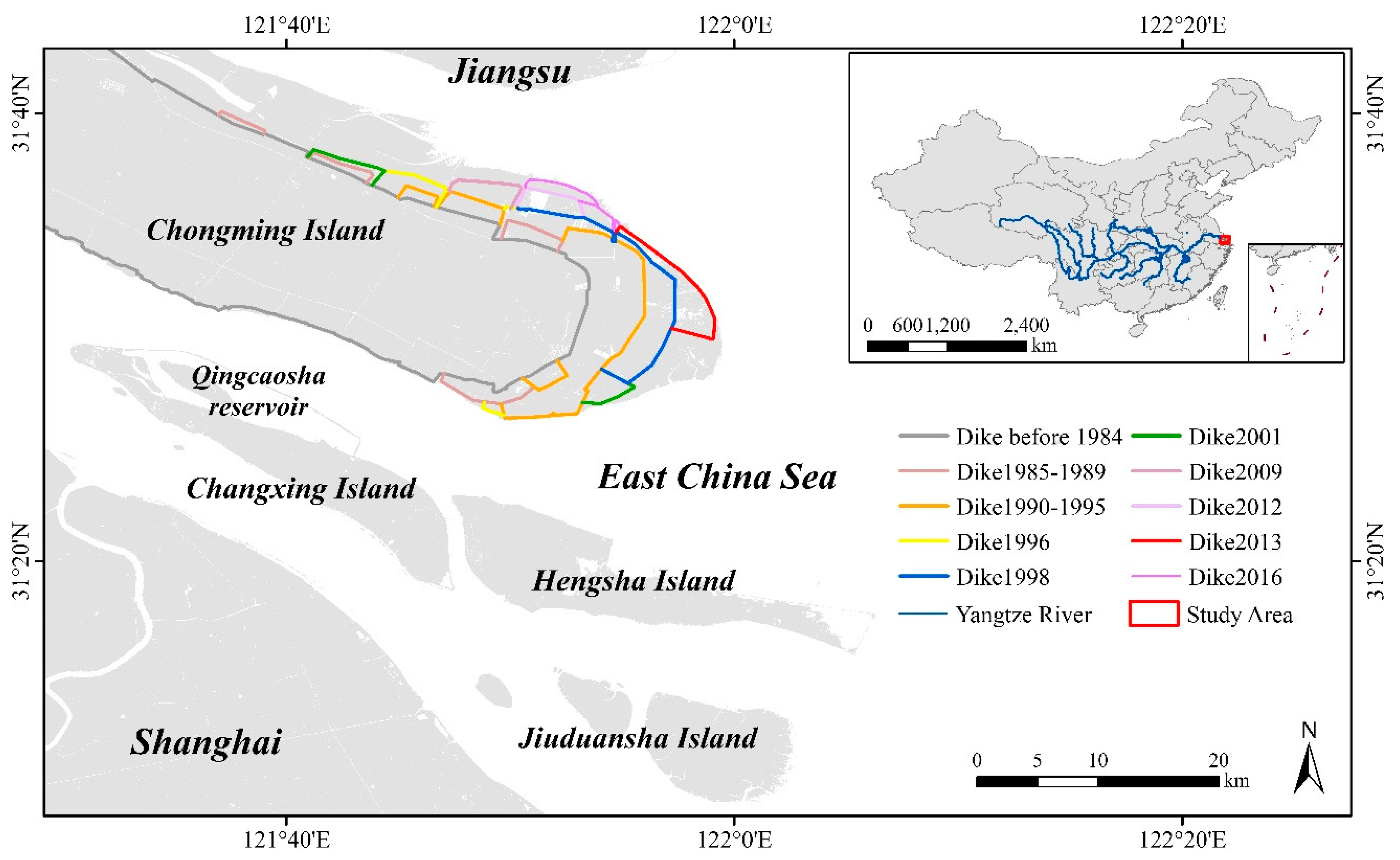

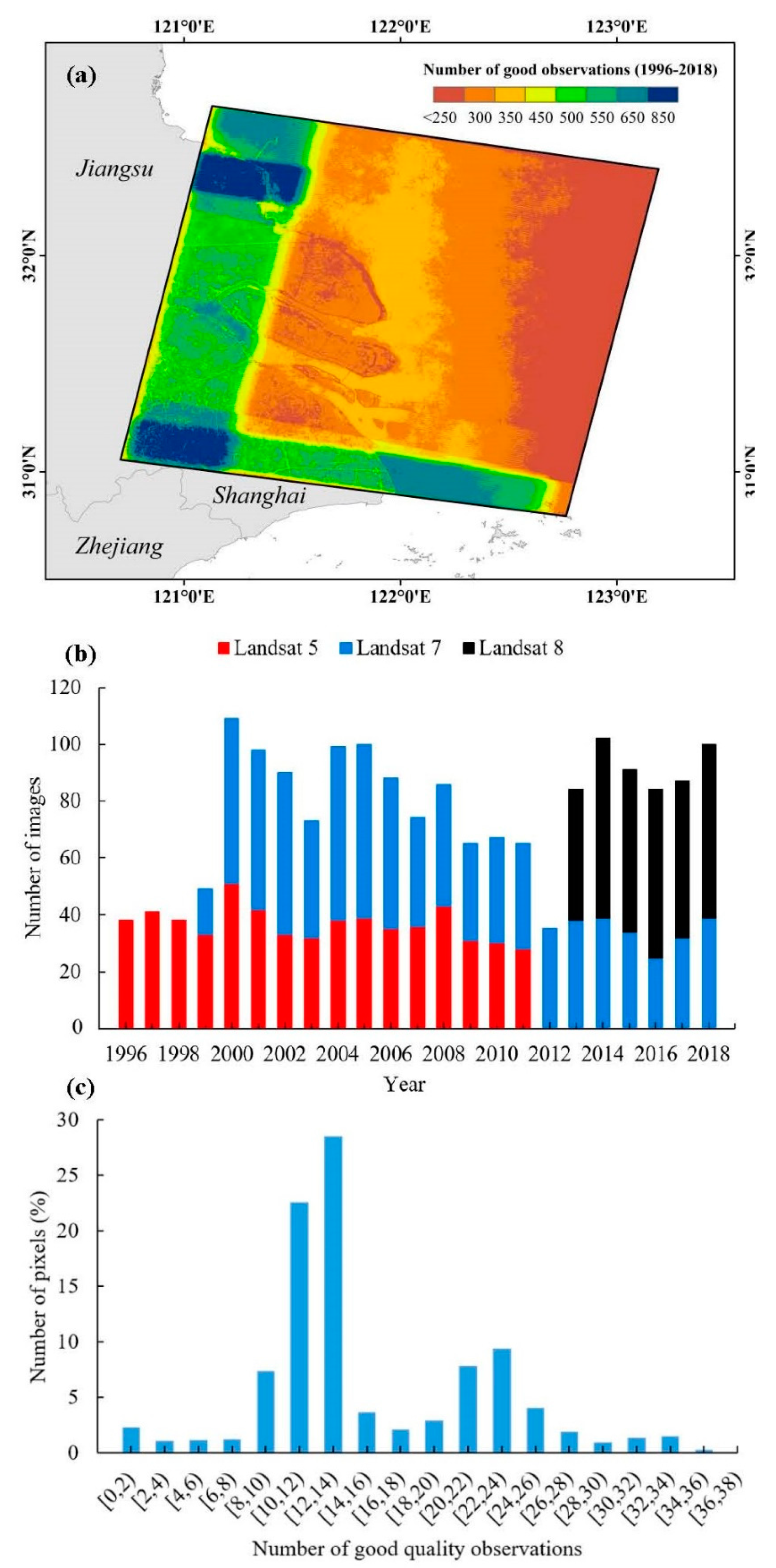
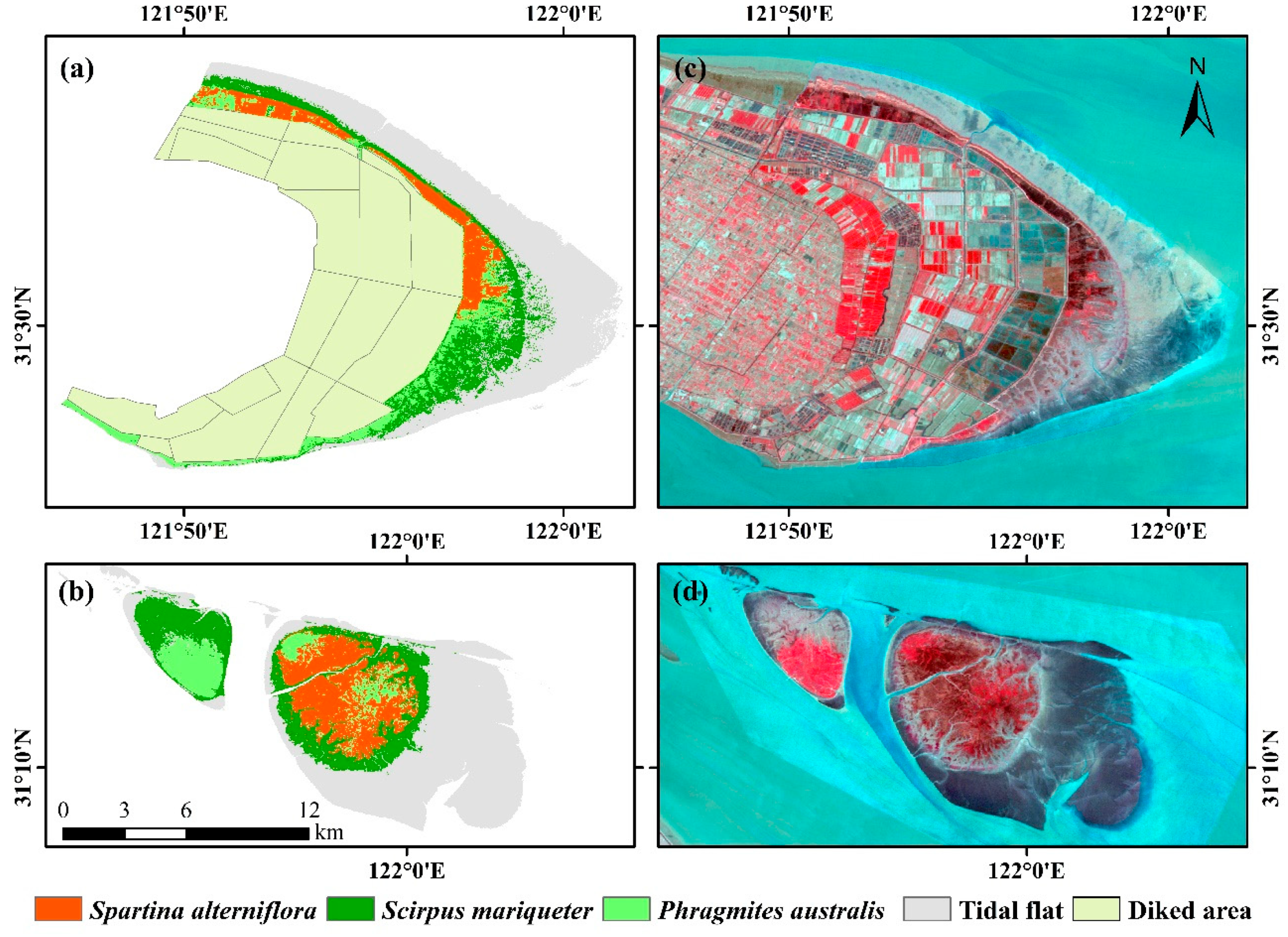
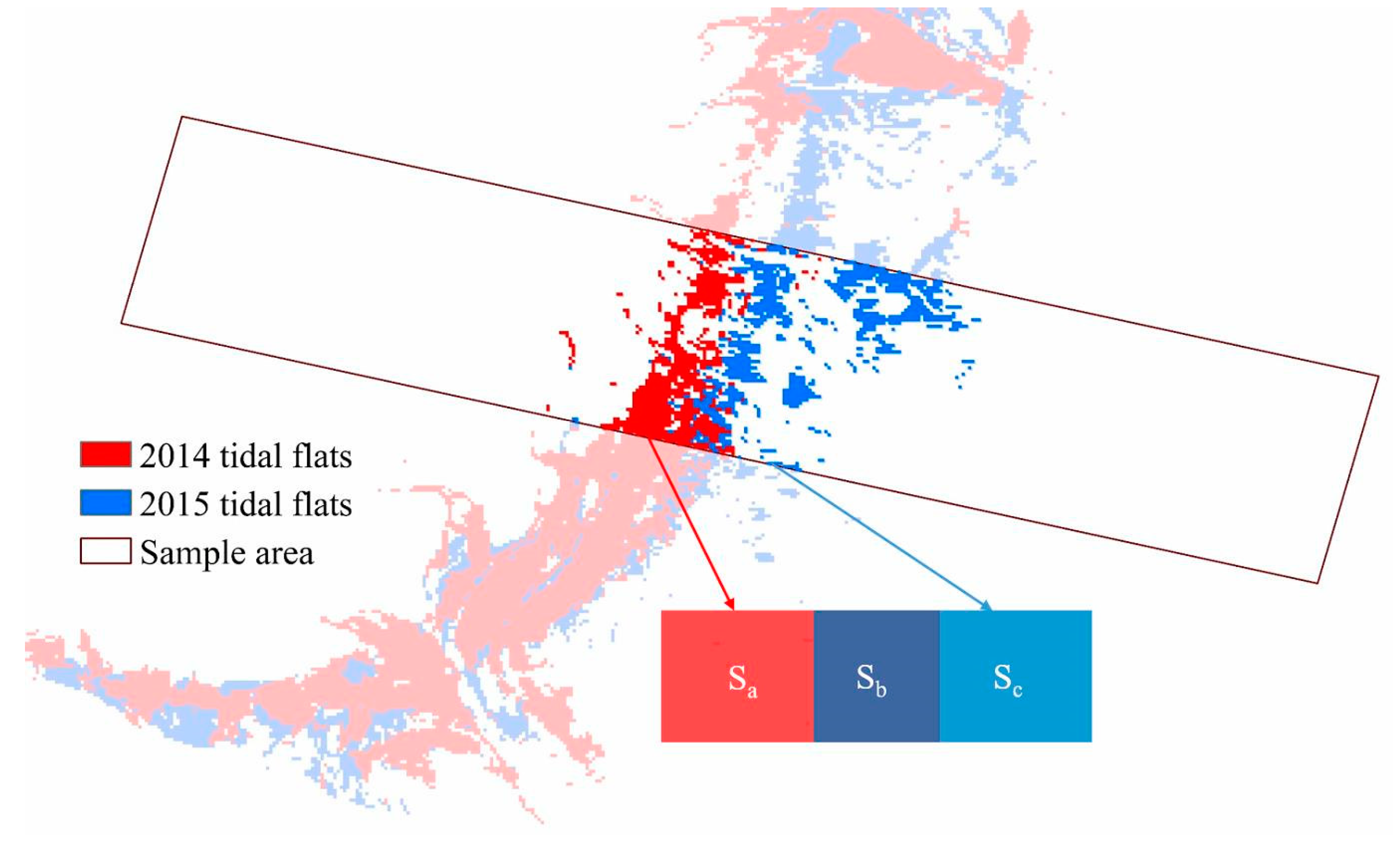
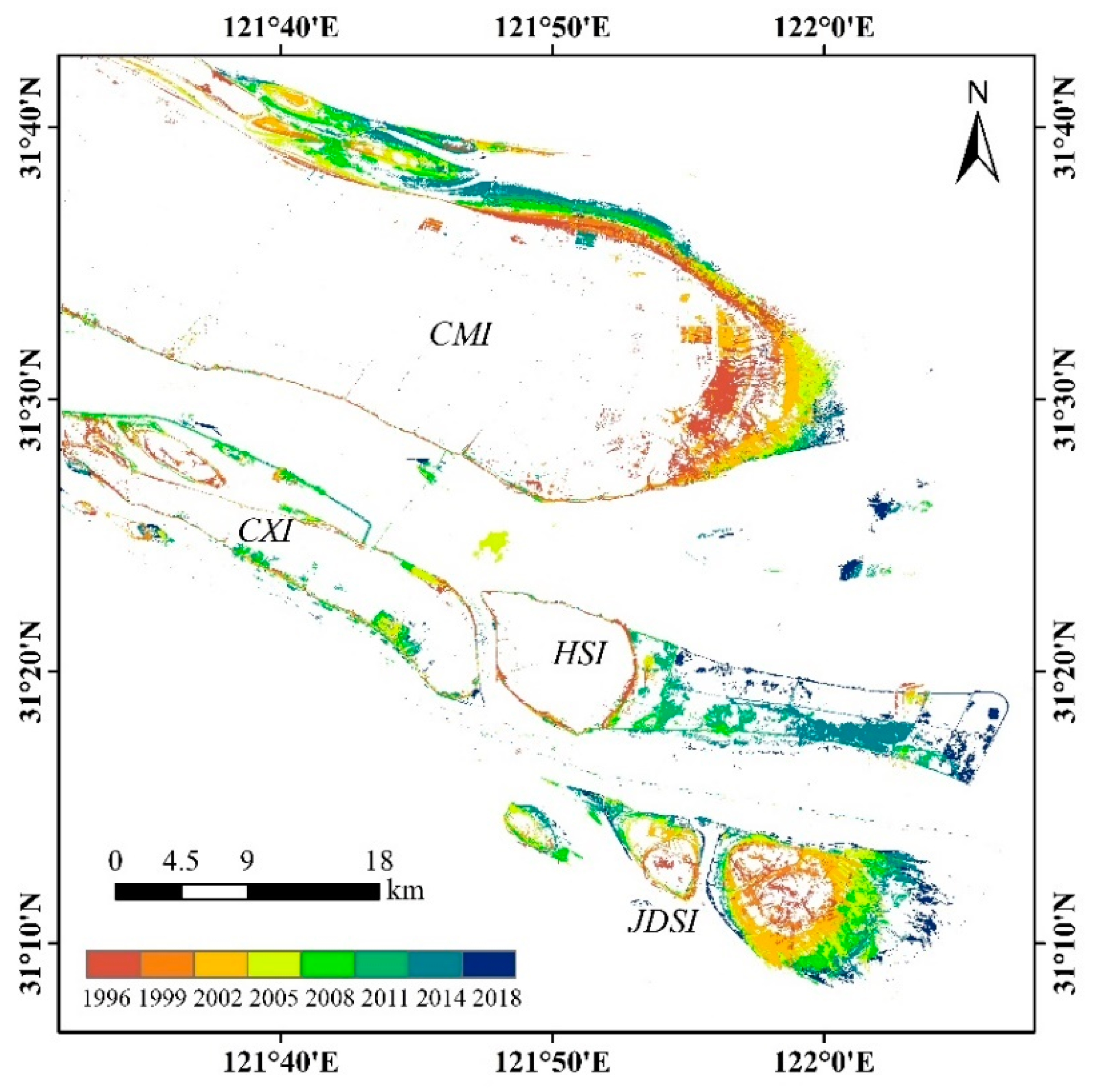

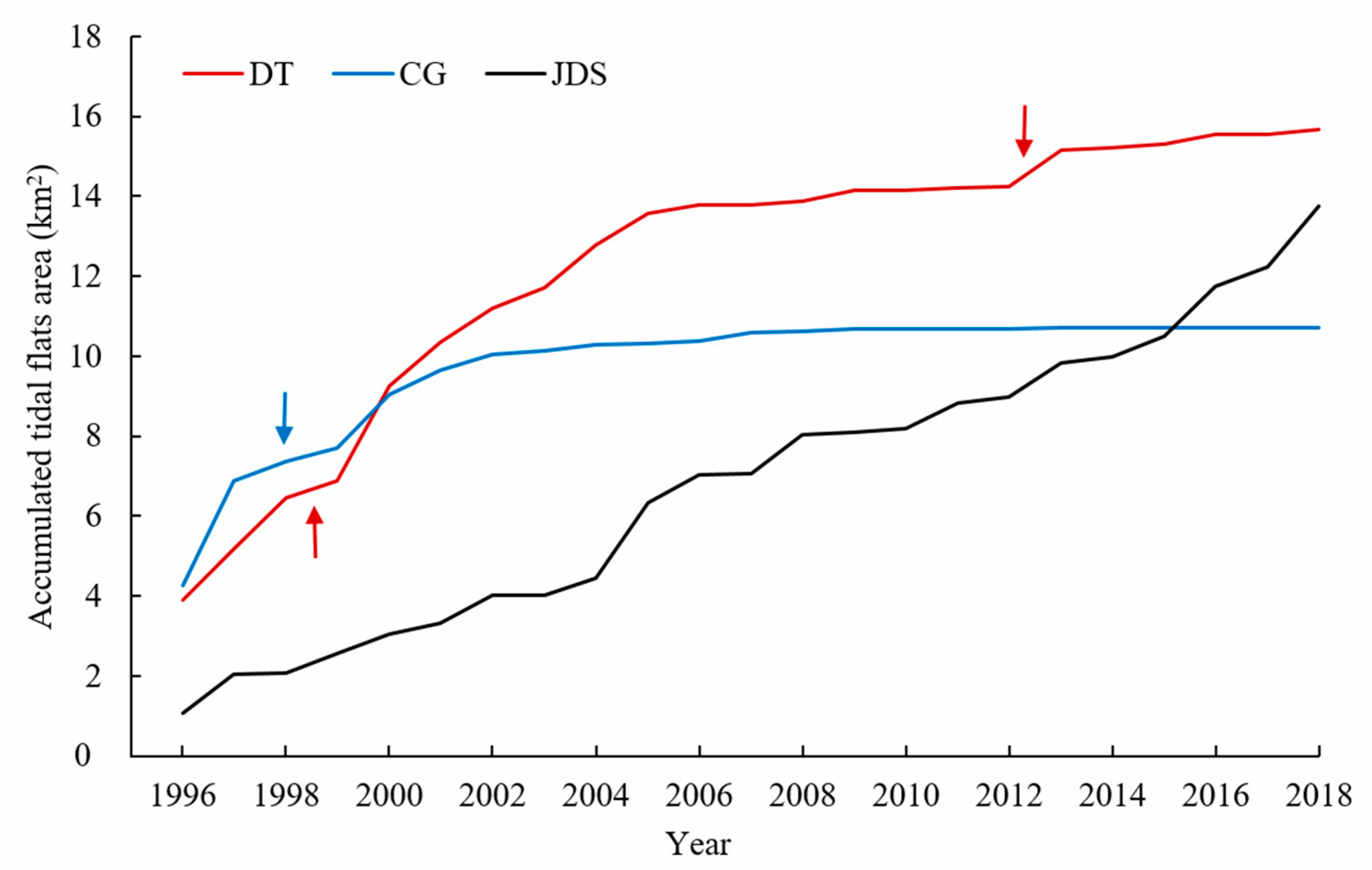
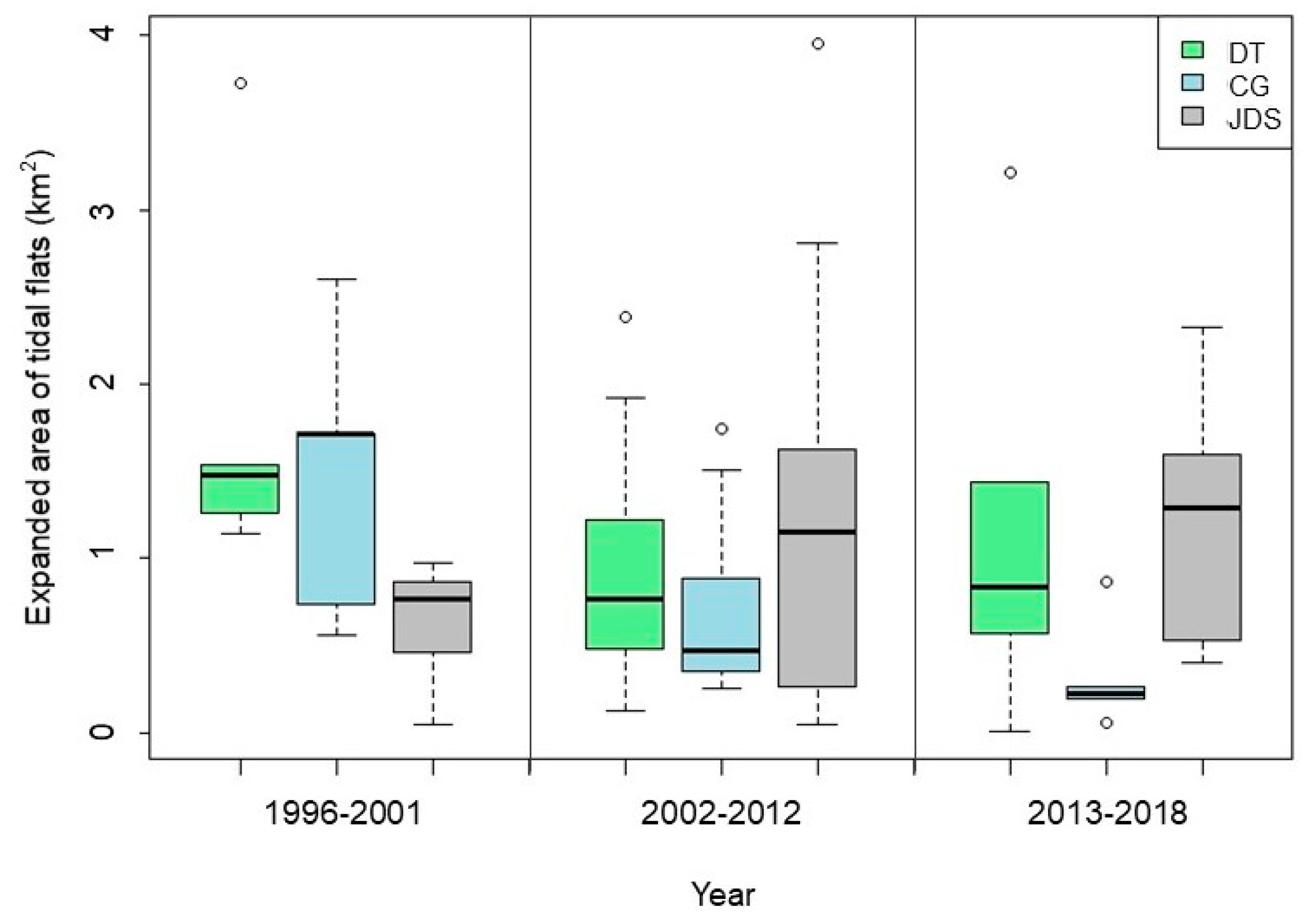
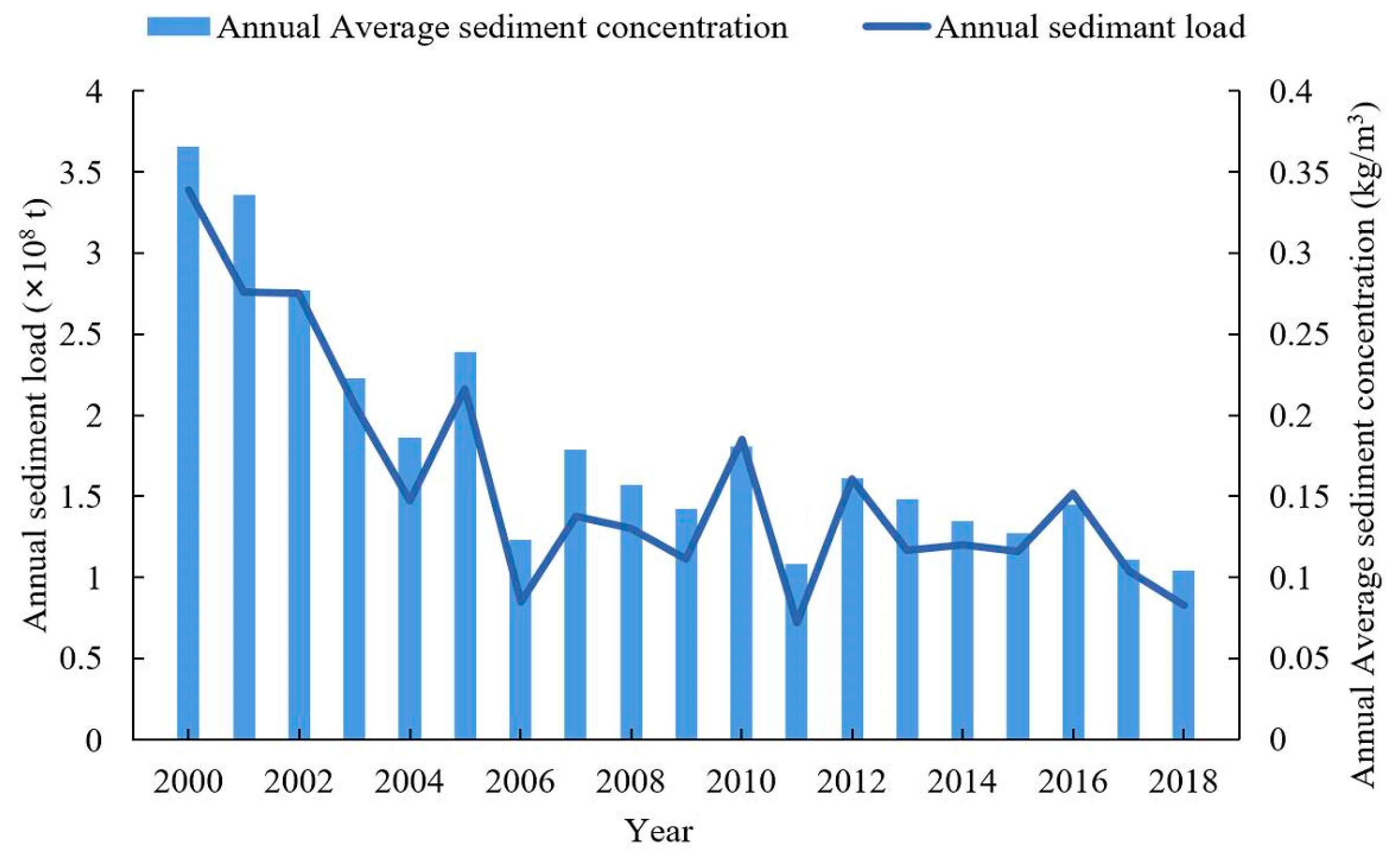
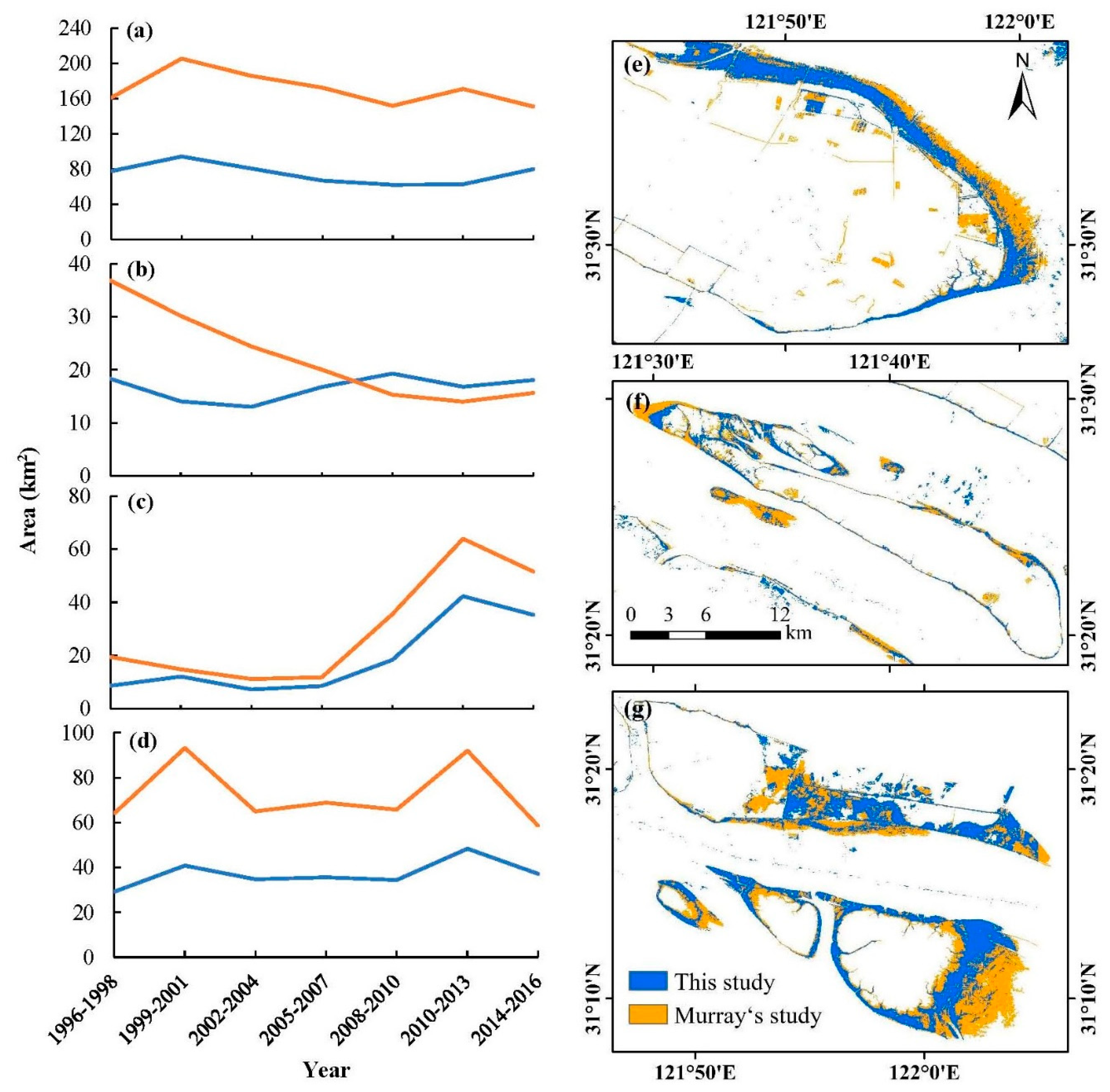
| Selected Years | Study Area | Region | Global |
|---|---|---|---|
| 1990,2000 | China | Gong et al. (2010) [36] | |
| 1978,1990,2000,2008 | China | Niu et al. (2012) [37] | |
| 1985,1990,1995,2000, 2005,2010,2014 | Yangtze River estuary | Chen et al. (2016) [39] | |
| 2010 | Global | Gong et al. (2013) [34] | |
| 2015 | China | Chen et al. (2017) [27] | |
| 2015 | China | Liu et al. (2018) [23] | |
| 2015 | China eastern coastal zone | Zhang et al. (2019) [40] | |
| 1995,2015 | China | Han et al. (2019) [41] | |
| 2017 | Global | Gong et al. (2019) [35] | |
| 1984–2015 | Yellow River estuary | Chen et al. (2019) [43] | |
| 1984–2016 | Global | Murray et al. (2019) [8] | |
| 1984–2016 | China | Wang et al. (2018) [42] | |
| 1996–2018 | Yangtze River estuary | This study |
| Ground Reference Pixels | Total Map Pixels | User’s Accuracy | |||||||
|---|---|---|---|---|---|---|---|---|---|
| Class | S. alterniflora | S. mariqueter | P. australia | Tidal Flats | Water | Diked Area | |||
| Map pixels | S. alterniflora | 129 | 6 | 3 | 0 | 0 | 0 | 138 | 93.48% |
| S. mariqueter | 4 | 111 | 4 | 13 | 0 | 0 | 132 | 84.09% | |
| P. australia | 3 | 7 | 65 | 1 | 0 | 0 | 76 | 85.53% | |
| Tidal flats | 1 | 4 | 1 | 223 | 2 | 0 | 231 | 96.54% | |
| Water | 0 | 0 | 0 | 2 | 368 | 0 | 370 | 99.46% | |
| Diked area | 1 | 2 | 0 | 0 | 0 | 50 | 53 | 94.34% | |
| Total ground truth pixels | 138 | 130 | 73 | 239 | 370 | 50 | 1000 | ||
| Producer’s accuracy | 93.48% | 85.38% | 89.04% | 93.31% | 99.46% | 100% | |||
| Area (km2) | CMI | CXI | HSI | JDSI | |
|---|---|---|---|---|---|
| Tidal flats area | Average 1 | 33.68 ± 4.63 | 8.37 ± 1.01 | 8.25 ± 2.61 | 17.42 ± 3.03 |
| Maximum 2 | 51.06 (2002) | 12.20 (1997) | 24.44 (2013) | 37.44 (2013) | |
| Minimum 2 | 8.81 (2017) | 4.30 (2003) | 1.39 (2003) | 5.27 (2007) | |
| Island area | Average 1 | 1410.53 ± 23.65 | 134.48 ± 8.55 | 81.49 ± 14.67 | 57.30 ± 11.80 |
| Maximum 2 | 1507.24 (2017) | 159.87 (2017) | 175.34 (2018) | 106.24 (2018) | |
| Minimum 2 | 1321.71 (1996) | 113.71 (2005) | 56.12 (1999) | 9.70 (1996) | |
| Islands and Samples | Formula 1 | Adjusted R2 |
|---|---|---|
| CMI | T = −45.08SC*** − 17.40SA** + 9.53R + 1427.94*** | 0.778 *** |
| CXI | T = −0.90SC + 8.24R*** + 119.85*** | 0.803 *** |
| HSI | T = −18.94SC* + 12.36R + 86.58*** | 0.349 * |
| JDSI | T = 2.97SC + 26.96SA*** + 65.74*** | 0.954 *** |
| Sample DT | T = −0.67SC* + 0.94SA** + 12.74*** (~2013) | 0.915 *** |
| T = −1.78SC*** − 0.19SA + 0.20R + 13.65*** | 0.857 *** | |
| Sample CG | T = −0.41SC*** + 10.42*** | 0.837 *** |
| Sample JDS | T = −0.609SC* + 2.53SA*** + 7.87*** | 0.938 *** |
© 2020 by the authors. Licensee MDPI, Basel, Switzerland. This article is an open access article distributed under the terms and conditions of the Creative Commons Attribution (CC BY) license (http://creativecommons.org/licenses/by/4.0/).
Share and Cite
Liu, Y.-F.; Ma, J.; Wang, X.-X.; Zhong, Q.-Y.; Zong, J.-M.; Wu, W.-B.; Wang, Q.; Zhao, B. Joint Effect of Spartina alterniflora Invasion and Reclamation on the Spatial and Temporal Dynamics of Tidal Flats in Yangtze River Estuary. Remote Sens. 2020, 12, 1725. https://doi.org/10.3390/rs12111725
Liu Y-F, Ma J, Wang X-X, Zhong Q-Y, Zong J-M, Wu W-B, Wang Q, Zhao B. Joint Effect of Spartina alterniflora Invasion and Reclamation on the Spatial and Temporal Dynamics of Tidal Flats in Yangtze River Estuary. Remote Sensing. 2020; 12(11):1725. https://doi.org/10.3390/rs12111725
Chicago/Turabian StyleLiu, Yi-Fei, Jun Ma, Xin-Xin Wang, Qiao-Yan Zhong, Jia-Min Zong, Wan-Ben Wu, Qing Wang, and Bin Zhao. 2020. "Joint Effect of Spartina alterniflora Invasion and Reclamation on the Spatial and Temporal Dynamics of Tidal Flats in Yangtze River Estuary" Remote Sensing 12, no. 11: 1725. https://doi.org/10.3390/rs12111725






